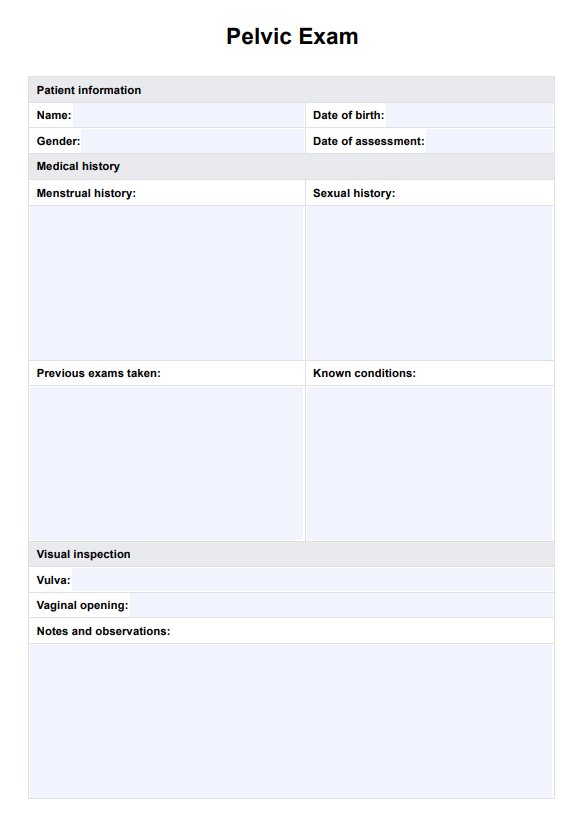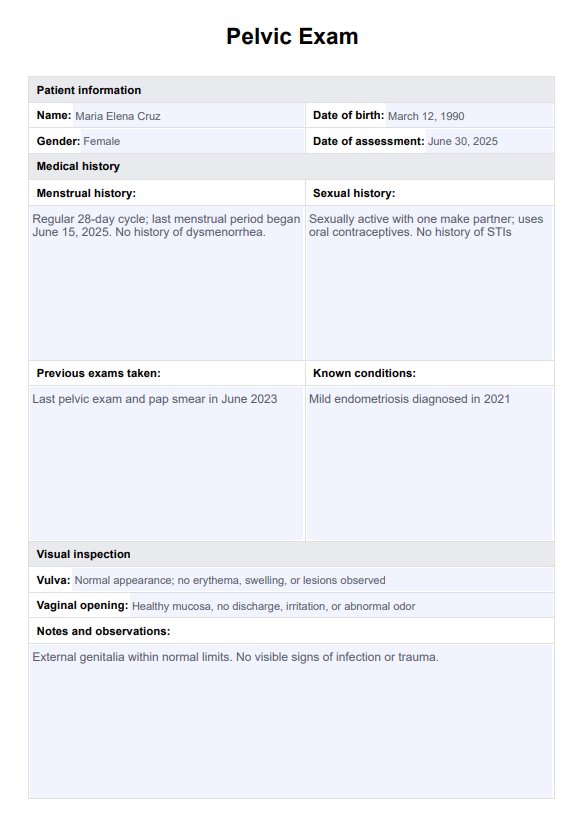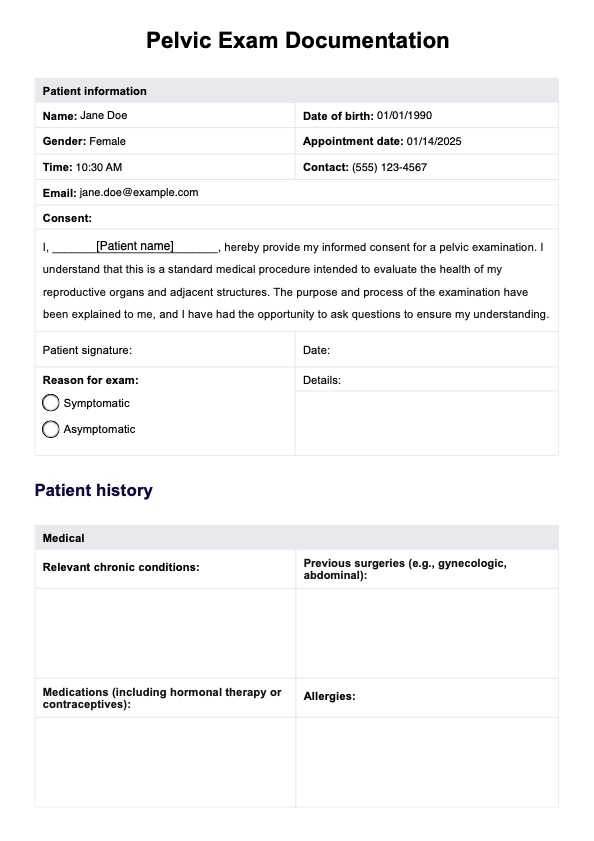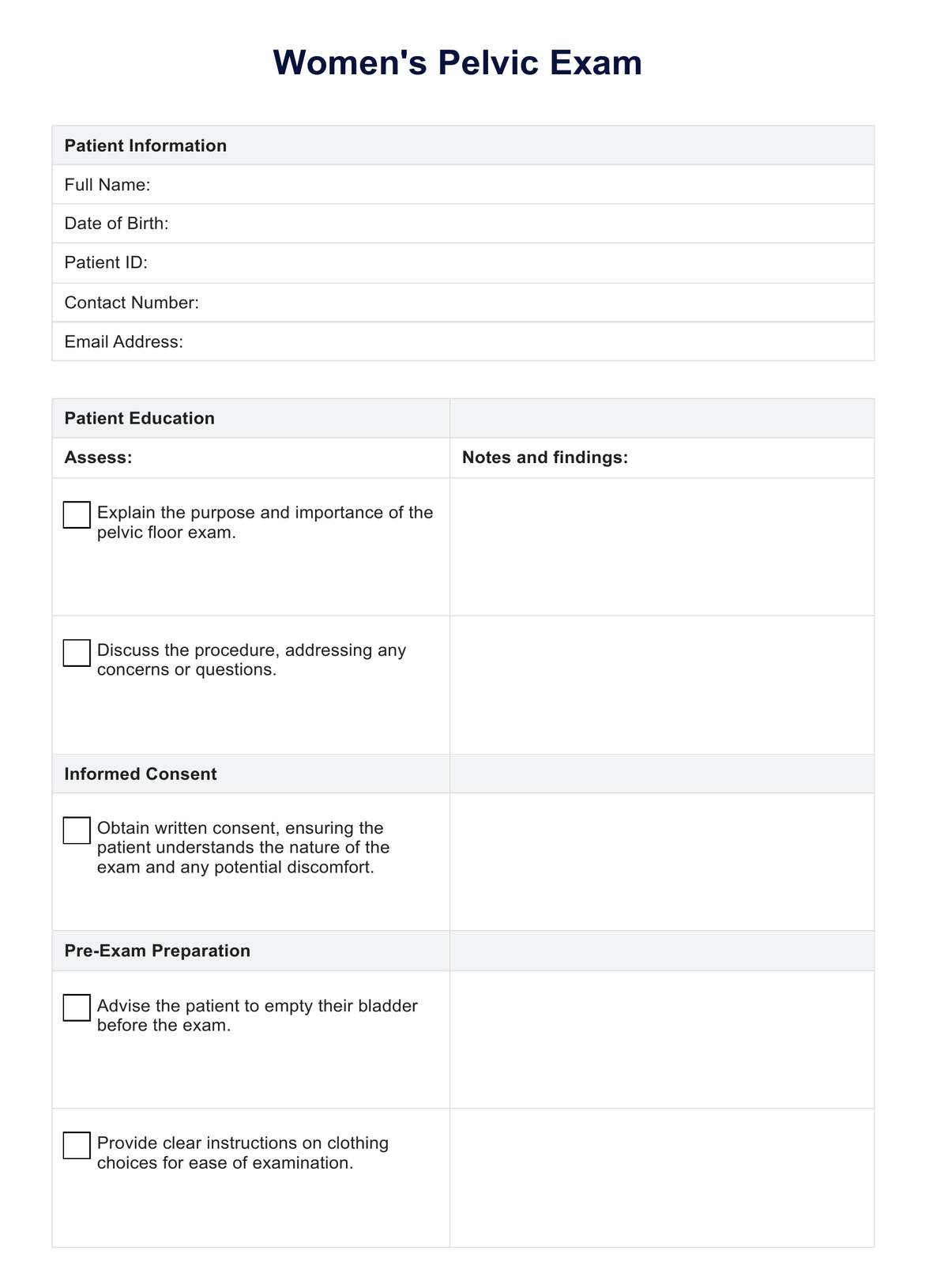Pelvic Exam
Discover Carepatron, the ultimate physician software with an advanced online patient portal and telehealth platform, streamlining healthcare management.


Introduction to the function of the pelvis
Welcome to the world of the pelvis, a marvel of the human body that's more than just a bony structure at your lower torso. Think of the pelvis as a central station where several critical functions converge. It's not just the cradle of your skeleton; it's a powerhouse of support and protection.
The pelvis is a sturdy muscle anchor and protective case for essential organs. It houses the uterus, ovaries, and bladder for women, while in men, it cradles the bladder and other vital parts. It's like a protective fortress, safeguarding these internal organs while providing a base for muscle attachment.
But that's not all! The pelvis is also a key player in the movement. The bridge connects your upper and lower body, crucial in maintaining balance and supporting your body's weight. Whether running, dancing, or sitting, your pelvis works overtime to keep everything in harmony.
So, when we talk about the pelvis, we talk about a multitasking hero. It's a structure that deserves a few minutes of attention and care, bringing us to routine pelvic exams.
Pelvic Exam Template
Pelvic Exam Example
What is a pelvic exam?
A pelvic exam is like a routine checkup for your pelvic region. It's a way for doctors to ensure everything in your pelvic station runs smoothly. Think of it as an annual maintenance checkup for your body's central hub.
During a pelvic exam, a healthcare provider examines the pelvic area, including the vulva, vagina, cervix, uterus, ovaries, and bladder. It's like a tour of the pelvic region, with the doctor or nurse as your guide, ensuring that each part is healthy and functioning.
The exam typically involves a visual inspection, a manual palpation where the doctor feels for any abnormalities, and sometimes a Pap test, where cells from the cervix are collected to check for cervical cancer. It's a comprehensive review, ensuring all is well in the pelvic region.
For many women, a pelvic exam is a regular part of their health routine, usually starting in their late teens or early twenties. Monitoring reproductive health, identifying potential issues early, and ensuring overall pelvic health are crucial.
In summary, a pelvic exam is an essential tool in women's health, providing valuable insights into the well-being of the pelvic region. It's a small step that plays a big part in maintaining overall health and wellness.
How does this exam work?
A pelvic exam is a routine procedure performed by healthcare professionals to assess the health of the female reproductive organs. Here's a step-by-step guide on how the pelvic exam procedure typically works:
Preparation and privacy
The exam begins with a medical assistant who ensures the patient's comfort and privacy. The patient is taken to a private examination room and given instructions on preparing, usually involving undressing from the waist down and using a gown for modesty.
Initial consultation
Before the physical exam, the healthcare professional discusses the patient's medical history, menstrual cycle, sexual activity, and any symptoms or health concerns. This conversation helps tailor the examination to the patient's specific needs.
Visual inspection
The external genital area is visually inspected for abnormalities, signs of infection, vaginal discharge, or other issues. This includes checking the vulva and the opening of the vagina.
Manual examination
The healthcare professional conducts a manual examination to assess the internal reproductive organs. This involves palpating the abdomen and an internal examination of the cervix, uterus, and ovaries through the vaginal walls.
Pap test
If necessary, a Pap test is performed. A speculum is used to widen the vaginal opening, and a small sample of cells is collected from the cervix for laboratory analysis.
Discussion and recommendations
After the exam, the healthcare professional discusses the findings with the patient, provides recommendations, and schedules follow-up appointments or additional tests.
This comprehensive approach ensures a thorough evaluation of the patient's pelvic health, addressing concerns and promoting preventive healthcare.
Interpreting the results
Interpreting the results of a pelvic exam is a critical step in ensuring comprehensive women's health care. After the exam, healthcare professionals analyze the findings to identify any abnormalities or concerns.
- Identifying abnormalities: The first step is to review the results for any signs of abnormalities in the pelvic organs. This includes noting any unusual uterus, ovaries, or cervix findings identified during the manual examination.
- Analyzing Pap test results: If a Pap test was conducted, its results are crucial in screening for cervical cancer. Abnormal cell changes may require further investigation or follow-up
- testing.
- Evaluating patient symptoms: The healthcare professional correlates the physical findings with any symptoms or concerns the patient may have reported. This helps in diagnosing conditions like infections, fibroids, or endometriosis.
- Consulting medical history: The patient's medical history, including menstrual cycle details and sexual health, is considered alongside the exam results to understand her health status comprehensively.
- Formulating a diagnosis: Based on the combined information from the exam, symptoms, and medical history, the healthcare professional formulates a diagnosis or decides on the need for additional tests or referrals.
Next steps for improving pelvic health
Following a pelvic exam, several steps can be taken to improve pelvic pain or maintain pelvic health:
- Follow-up care: If any abnormalities are found, appropriate follow-up care, which may include additional tests or specialist referrals, is crucial.
- Lifestyle modifications: Recommendations may be made to improve pelvic health, such as dietary adjustments, regular exercise, or pelvic floor exercises.
- Regular screenings: Regular pelvic exams and Pap tests are essential for early detection of potential health issues, especially for women at risk of certain conditions like cervical cancer.
- Addressing symptoms: If the patient reports pain or irregular bleeding, specific treatments or interventions might be recommended to address these issues.
- Educational resources: Providing patients with educational resources about pelvic health can empower them to make informed decisions about their care and lifestyle.
Benefits of using this exam template
Standardized documentation
The template ensures that all relevant aspects of the pelvic exam are systematically documented, promoting thoroughness and consistency in patient care.
Enhanced communication
Clear documentation aids in communication among healthcare providers, especially if the patient needs to be referred to a specialist.
Improved patient care
A detailed template helps capture a complete picture of the patient's pelvic health, leading to more accurate diagnoses and tailored treatment plans.
Educational tool
The template is an educational tool for new healthcare professionals, providing a clear structure for conducting and documenting pelvic exams.
Efficient record-keeping
The template simplifies record-keeping, making it easier to track patient health changes over time and during follow-up visits.
Commonly asked questions
Carepatron is designed to integrate seamlessly with existing electronic health record systems, enhancing data accessibility and workflow efficiency.
Absolutely, Carepatron provides customizable features that can be tailored to meet the specific needs of various medical specialties, ensuring a personalized user experience.
Carepatron prioritizes the privacy and security of patient data by adhering to healthcare regulations and employing advanced security measures to protect sensitive information.















































































































